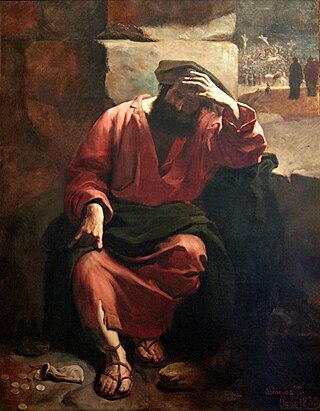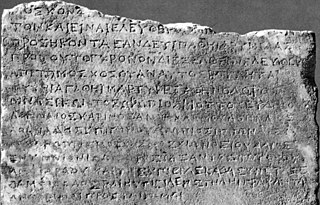Related Research Articles
Antisemitism and the New Testament is the discussion of how some Christians' views of Judaism in the New Testament have contributed to discrimination against Jewish people throughout history and in the present day.

Judas Iscariot was—according to Christianity's four canonical gospels—a first-century Jewish man who became a disciple and one of the original Twelve Apostles of Jesus Christ. Judas betrayed Jesus to the Sanhedrin in the Garden of Gethsemane, in exchange for 30 pieces of silver, by kissing him on the cheek and addressing him as "master" to reveal his identity in the darkness to the crowd who had come to arrest him. In modern times, his name is often used synonymously with betrayal or treason.
The Sadducees were a sect of Jews active in Judea during the Second Temple period, from the second century BCE to the destruction of the Second Temple in 70 CE. The Sadducees are described in contemporary literary sources in contrast to the two other major sects at the time, the Pharisees and the Essenes.

Simon the Zealot or Simon the Canaanite or Simon the Canaanean was one of the most obscure among the apostles of Jesus. A few pseudepigraphical writings were connected to him, but Jerome does not include him in De viris illustribus written between 392 and 393 AD.
2 Maccabees, also known as the Second Book of Maccabees, Second Maccabees, and abbreviated as 2 Macc., is a deuterocanonical book which recounts the persecution of Jews under King Antiochus IV Epiphanes and the Maccabean Revolt against him. It concludes with the defeat of the Seleucid Empire general Nicanor in 161 BC by Judas Maccabeus, the leader of the Maccabees.

Pseudepigrapha are falsely attributed works, texts whose claimed author is not the true author, or a work whose real author attributed it to a figure of the past. The name of the author to whom the work is falsely attributed is often prefixed with the particle "pseudo-", such as for example "pseudo-Aristotle" or "pseudo-Dionysius": these terms refer to the anonymous authors of works falsely attributed to Aristotle and Dionysius the Areopagite, respectively.

Jude was one of the Twelve Apostles of Jesus according to the New Testament. He is generally identified as Thaddeus and is also variously called Judas Thaddaeus, Jude Thaddaeus, Jude of James, or Lebbaeus. He is sometimes identified with Jude, the brother of Jesus, but is clearly distinguished from Judas Iscariot, the disciple who betrayed Jesus prior to his crucifixion. Catholic writer Michal Hunt suggests that Judas Thaddaeus became known as Jude after early translators of the New Testament from Greek into English sought to distinguish him from Judas Iscariot and subsequently abbreviated his forename. Most versions of the New Testament in languages other than English and French refer to Judas and Jude by the same name.

The Gospel of Judas is a non-canonical Gnostic gospel. The content consists of conversations between Jesus and Judas Iscariot. Given that it includes late 2nd-century theology, it is widely thought to have been composed in the 2nd century by Gnostic Christians. The only copy of it known to exist is a Coptic language text that has been carbon dated to 280 AD, plus or minus 60 years. It has been suggested that the text derives from an earlier manuscript in the Greek language. An English translation was first published in early 2006 by the National Geographic Society.

Generically, a Galilean is a term that was used in classical sources to describe the inhabitants of Galilee, an area of northern Israel and southern Lebanon that extends from the northern coastal plain in the west to the Sea of Galilee and the Jordan Rift Valley to the east.

The ministry of Jesus, in the canonical gospels, begins with his baptism near the River Jordan by John the Baptist, and ends in Jerusalem in Judea, following the Last Supper with his disciples. The Gospel of Luke states that Jesus was "about 30 years of age" at the start of his ministry. A chronology of Jesus typically sets the date of the start of his ministry at around AD 27–29 and the end in the range AD 30–36.
The unknown years of Jesus generally refers to the period of Jesus's life between his childhood and the beginning of his ministry, a period not described in the New Testament.

The Maccabean Revolt was a Jewish rebellion led by the Maccabees against the Seleucid Empire and against Hellenistic influence on Jewish life. The main phase of the revolt lasted from 167 to 160 BCE and ended with the Seleucids in control of Judea, but conflict between the Maccabees, Hellenized Jews, and the Seleucids continued until 134 BCE, with the Maccabees eventually attaining independence.
Deicide is the killing of a god. The concept may be used for any act of killing a god, including a life-death-rebirth deity who is killed and then resurrected.

Jesus the Man: New Interpretations from the Dead Sea Scrolls is a book written by the Australian biblical scholar and theologian Barbara Thiering. It was first published by Doubleday in 1992 with the title, Jesus & The Riddle of The Dead Sea Scrolls: Unlocking The Secrets of His Life Story.
Craig Alan Evans is an American biblical scholar. He is a prolific writer with 70 books and over 600 journal articles and reviews to his name.

The Assassini is a 1990 thriller novel by American author Thomas Gifford, published by Bantam Books.
Secacah is a town mentioned in the Hebrew Bible/Old Testament as well as in the Dead Sea Scrolls. The town was located in the wilderness of Judah, otherwise known as the Judean Desert, and is identified by some scholars with the archaeological site of Khirbet Qumran.

Ioudaios is an Ancient Greek ethnonym used in classical and biblical literature which commonly translates to "Jew" or "Judean".

Meredith J. C. Warren is a Senior Lecturer in Biblical and Religious Studies at the University of Sheffield. She is known for her views on the New Testament and early Judaism as well as for her media appearances for such outlets as The Washington Post, and BBC radio. She is a Metis citizen of the Manitoba Metis Federation.

The names Judas and Jude, both derived from the Greek Ἰούδας (Ioúdas), itself derived from the Hebrew name Judah together appear 36 times in the New Testament. Judas was a very common given name in the historical period and region of Jesus, due to the renowned hero Judas Maccabeus. As surnames were still very rare, it is therefore not always clear which person these names refer to, and whether some refer to the same person or distinct characters, which has led to confusion. Therefore, Christian authors and modern scholars have given these men names based on their known attributes. 'Judas' is sometimes rendered as 'Jude' in English in order to help distinguish some of the people named Ἰούδας in the New Testament, even though the original Greek texts make no such distinction.
References
- 1 2 Easterman, Daniel (2004). The Judas Testament . Harpercollins. ISBN 0-06-017768-3.